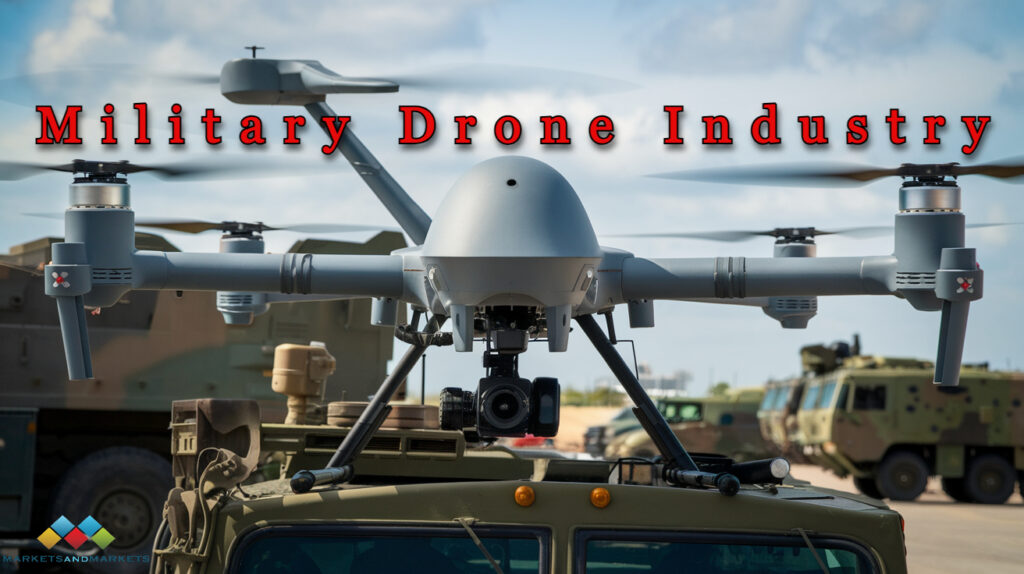The Military Drone Industry plays a crucial role in modern defense strategies, providing innovative solutions for surveillance, reconnaissance, combat missions, and logistical support. With rapid advancements in drone technology, these unmanned aerial vehicles (UAVs) provide militaries with the ability to execute precise missions while minimizing risks to personnel. The industry is driven by increasing global demand for autonomous systems, enhanced defense strategies, and the need for cost-effective solutions in warfare. From border surveillance to targeted strikes and maritime patrols, military drones are reshaping the battlefield, offering unmatched efficiency, flexibility, and operational reach.
The military drone industry is projected to expand significantly, increasing from USD 13.0 billion in 2023 to USD 18.2 billion by 2028, with a CAGR of 7.0%. This rise is fueled by growing global investments in cutting-edge defense technologies, as countries strive to strengthen their military capabilities. The escalating need for Unmanned Aerial Vehicles (UAVs) is particularly driven by increasing maritime patrolling and anti-piracy operations across regions like South America, Central Asia, West Africa, and the Indian subcontinent.

Market Segmentation Overview
- By Propulsion
The market is segmented into turbo engines, piston engines, and battery-powered drones. The battery-powered segment is expected to grow at an impressive rate of 16.2% during the forecast period. Advances in lithium-ion batteries, fuel cells, and hybrid cell technologies are accelerating the adoption of battery-powered drones for short- and medium-range operations. High-endurance drones, which are critical in strategic missions, typically rely on turbo engines like gas-powered turbojets and turbofans. - By Speed
Drones are categorized into subsonic and supersonic segments based on speed. The subsonic segment, operating at speeds of less than Mach 0.8, remains the most prevalent, covering drones traveling below the speed of sound. Subsonic drones account for a significant portion of the military drone market, largely due to their versatility and widespread usage in autonomous operations.
Key Advantages of Military Drones
- Reduced Risk to Soldiers: Drones can operate in high-risk environments without endangering human life. This ability is particularly beneficial for missions in hostile or remote locations.
- Cost Efficiency: Compared to manned aircraft, drones are more cost-effective in terms of both production and operation. They require fewer personnel and lower maintenance costs.
- Real-Time Data and Precision: Drones provide real-time imagery and data that help military forces make informed decisions quickly. In combat scenarios, drones deliver pinpoint accuracy, reducing the risk of unintended casualties.
Applications in Modern Warfare
Military drones have seen increasing use in a variety of operations, including:
- Border surveillance: Monitoring potential threats and illegal activities along national borders.
- Counter-terrorism: Conducting targeted strikes against terrorist leaders and their networks.
- Maritime patrols: Ensuring the security of national waters by detecting piracy and illegal activities.
- Search and rescue missions: Identifying and locating individuals in need of help in difficult-to-reach areas.
Geographical Focus
Asia Pacific is forecasted to be a high-growth region in the military drone market, driven by rapid technological advancements and substantial investments in defense infrastructure. Countries like China, India, South Korea, and Malaysia are leading the charge in developing sophisticated drone technology. China, with its formidable manufacturing capabilities and technological expertise, plays a pivotal role, supported by key domestic manufacturers like Autel Robotics and AVIC.
Major Players and Innovation Drivers
Leading global defense contractors shaping the industry include:
- Northrop Grumman Corporation (US)
- Raytheon Technologies Corporation (US)
- Israel Aerospace Industries Ltd. (Israel)
- General Atomics Aeronautical Systems (GA-ASI) (US)
- Teledyne FLIR LLC (US)
These companies are at the forefront of R&D, focusing on enhancing drone technologies to meet evolving military needs across various regions and operational requirements.
Future of Military Drones
As drone technology continues to evolve, future military UAVs are expected to feature greater autonomy, extended flight durations, and enhanced stealth capabilities. Advancements in artificial intelligence (AI) and machine learning will be pivotal in enabling drones to carry out more complex and sophisticated missions with minimal human involvement, further increasing their operational effectiveness. These innovations will allow UAVs to adapt to dynamic battlefield conditions, make real-time decisions, and execute precise maneuvers, transforming the role of drones in future military operations.